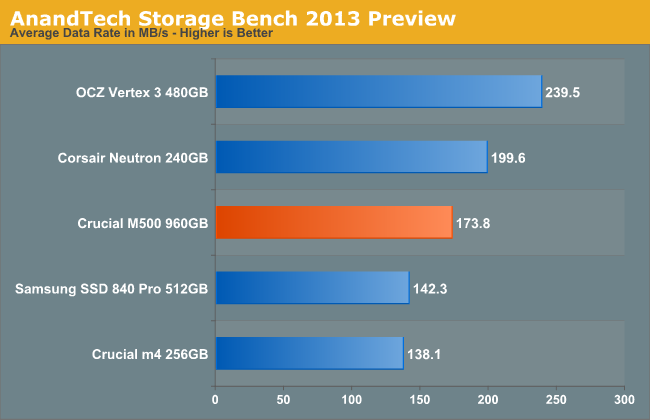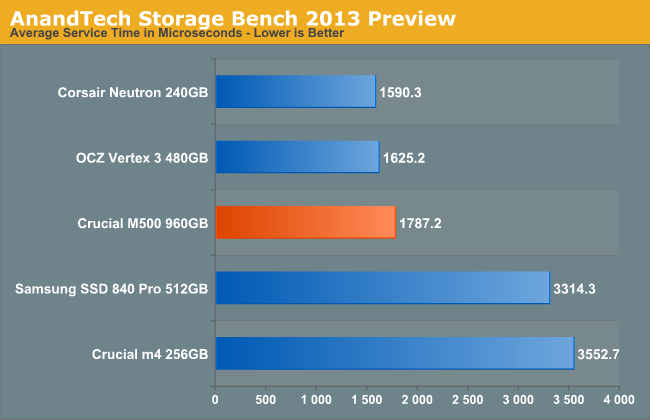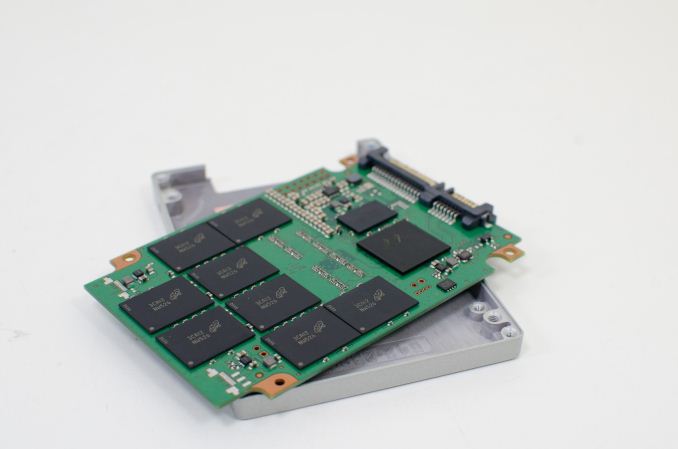The Crucial/Micron M500 Review (960GB, 480GB, 240GB, 120GB)
by Anand Lal Shimpi on April 9, 2013 9:59 AM ESTA Preview of The Destroyer, Our 2013 Storage Bench
When I built the AnandTech Heavy and Light Storage Bench suites in 2011 I did so because we didn't have any good tools at the time that would begin to stress a drive's garbage collection routines. Once all blocks have a sufficient number of used pages, all further writes will inevitably trigger some sort of garbage collection/block recycling algorithm. Our Heavy 2011 test in particular was designed to do just this. By hitting the test SSD with a large enough and write intensive enough workload, we could ensure that some amount of GC would happen.
There were a couple of issues with our 2011 tests that I've been wanting to rectify however. First off, all of our 2011 tests were built using Windows 7 x64 pre-SP1, which meant there were potentially some 4K alignment issues that wouldn't exist had we built the trace on a system with SP1. This didn't really impact most SSDs but it proved to be a problem with some hard drives. Secondly, and more recently, I've shifted focus from simply triggering GC routines to really looking at worst case scenario performance after prolonged random IO. For years I'd felt the negative impacts of inconsistent IO performance with all SSDs, but until the S3700 showed up I didn't think to actually measure and visualize IO consistency. The problem with our IO consistency tests are they are very focused on 4KB random writes at high queue depths and full LBA spans, not exactly a real world client usage model. The aspects of SSD architecture that those tests stress however are very important, and none of our existing tests were doing a good job of quantifying that.
I needed an updated heavy test, one that dealt with an even larger set of data and one that somehow incorporated IO consistency into its metrics. I think I've come up with the test, but given the short timeframe for this review (I only got my M500 drives a few days ago) I couldn't get a ton of data ready for you all today. The new benchmark doesn't even have a name, I've just been calling it The Destroyer (although AnandTech Storage Bench 2013 is likely a better fit for PR reasons).
Everything about this new test is bigger and better. The test platform moves to Windows 8 Pro x64. The workload is far more realistic. Just as before, this is an application trace based test - I record all IO requests made to a test system, then play them back on the drive I'm measuring and run statistical analysis on the drive's responses.
Imitating most modern benchmarks I crafted the Destroyer out of a series of scenarios. For this benchmark I focused heavily on Photo editing, Gaming, Virtualization, General Productivity, Video Playback and Application Development. Rough descriptions of the various scenarios are in the table below:
| AnandTech Storage Bench 2013 Preview - The Destroyer | ||||||||||||
| Workload | Description | Applications Used | ||||||||||
| Photo Sync/Editing | Import images, edit, export | Adobe Photoshop CS6, Adobe Lightroom 4, Dropbox | ||||||||||
| Gaming | Download/install games, play games | Steam, Deus Ex, Skyrim, Starcraft 2, BioShock Infinite | ||||||||||
| Virtualization | Run/manage VM, use general apps inside VM | VirtualBox | ||||||||||
| General Productivity | Browse the web, manage local email, copy files, encrypt/decrypt files, backup system, download content, virus/malware scan | Chrome, IE10, Outlook, Windows 8, AxCrypt, uTorrent, AdAware | ||||||||||
| Video Playback | Copy and watch movies | Windows 8 | ||||||||||
| Application Development | Compile projects, check out code, download code samples | Visual Studio 2012 | ||||||||||
While some tasks remained independent, many were stitched together (e.g. system backups would take place while other scenarios were taking place). The overall stats give some justification to what I've been calling this test internally:
| AnandTech Storage Bench 2013 Preview - The Destroyer, Specs | |||||||||||||
| The Destroyer (2013) | Heavy 2011 | ||||||||||||
| Reads | 38.83 million | 2.17 million | |||||||||||
| Writes | 10.98 million | 1.78 million | |||||||||||
| Total IO Operations | 49.8 million | 3.99 million | |||||||||||
| Total GB Read | 1583.02 GB | 48.63 GB | |||||||||||
| Total GB Written | 875.62 GB | 106.32 GB | |||||||||||
| Average Queue Depth | ~5.5 | ~4.6 | |||||||||||
| Focus | Worst case multitasking, IO consistency | Peak IO, basic GC routines | |||||||||||
SSDs have grown in their performance abilities over the years, so I wanted a new test that could really push high queue depths at times. The average queue depth is still realistic for a client workload, but the Destroyer has some very demanding peaks. When I first introduced the Heavy 2011 test, some drives would take multiple hours to complete it - today most high performance SSDs can finish the test in under 90 minutes. The Destroyer? So far the fastest I've seen it go is 10 hours. Most high performance I've tested seem to need around 12 - 13 hours per run, with mainstream drives taking closer to 24 hours. The read/write balance is also a lot more realistic than in the Heavy 2011 test. Back in 2011 I just needed something that had a ton of writes so I could start separating the good from the bad. Now that the drives have matured, I felt a test that was a bit more balanced would be a better idea.
Despite the balance recalibration, there's just a ton of data moving around in this test. Ultimately the sheer volume of data here and the fact that there's a good amount of random IO courtesy of all of the multitasking (e.g. background VM work, background photo exports/syncs, etc...) makes the Destroyer do a far better job of giving credit for performance consistency than the old Heavy 2011 test. Both tests are valid, they just stress/showcase different things. As the days of begging for better random IO performance and basic GC intelligence are over, I wanted a test that would give me a bit more of what I'm interested in these days. As I mentioned in the S3700 review - having good worst case IO performance and consistency matters just as much to client users as it does to enterprise users.
Given the sheer amount of time it takes to run through the Destroyer, and the fact that the test was only completed a little over a week ago, I don't have many results to share. I'll be populating this database over the coming weeks/months. I'm still hunting for any issues/weirdness with the test so I'm not ready to remove the "Preview" label from it just yet. But the results thus far are very telling.
I'm reporting two primary metrics with the Destroyer: average data rate in MB/s and average service time in microseconds. The former gives you an idea of the throughput of the drive during the time that it was running the Destroyer workload. This can be a very good indication of overall performance. What average data rate doesn't do a good job of is taking into account response time of very bursty (read: high queue depth) IO. By reporting average service time we heavily weigh latency for queued IOs. You'll note that this is a metric I've been reporting in our enterprise benchmarks for a while now. With the client tests maturing, the time was right for a little convergence.
I'll also report standard deviation for service times to give you some idea of IO consistency.

Average data rates already show us something very surprising. The Corsair Neutron, which definitely places below Samsung's SSD 840 Pro in our Heavy 2011 test, takes second place here. If you look at the IO consistency graphs from the previous page however, this shouldn't come as a huge shock. Without additional spare area, the 840 Pro can definitely back itself into a corner - very similar to the old m4 in fact. The M500 dramatically improves IO consistency and worst case scenario IO performance, and it shows.
The SF-2281 based Vertex 3 does extremely well, taking the crown. SandForce's real time compression/de-dupe engine has always given it wonderful performance, even when running these heavy workloads as long as there's some portion of data that's compressible. The problem with SandForce wasn't performance, it was always a reliability concern that drove us elsewhere.

The results are echoed here, and exaggerated quite significantly. The SF-2281 based Vertex 3 does very well as it's able to work as if it has more spare area thanks to the fact that some of the workload can be compressed in real time. I did fill all drives with incompressible data at first, but given that not all parts of the workload are incompressible the SandForce drive gets a bit of an advantage - similar to what would happen in the real world.
Note that the Vertex 3 and Neutron swap spots as we look at average service time. This is exactly what I was talking about earlier. Here we're looking more at how a drive handles bursty (high queue depth) workloads vs. overall performance in our suite. Both metrics are important, but this one is likely more relevant to how fast your system feels.

Although the Neutron clearly has the response time advantage, the M500 delivers a remarkably competitive consistency story. Absolute performance may not be great in its lowest performing state, but the M500 keeps things consistent. Comparing to the old m4 we see just how bad things used to be.











111 Comments
View All Comments
blackmagnum - Tuesday, April 9, 2013 - link
How times have changed. SSDs now have better bang-for-the-buck than hard disk drives. No noise, low power, shock resistance... the works.Flunk - Tuesday, April 9, 2013 - link
That's not quantitatively true. 2TB hard drives are available for about $100 which is 0.05/GB no SSD can match that.SSDs have better power usage, performance, shock resistance but they lag in capacity.
ABR - Tuesday, April 9, 2013 - link
Actually they tend NOT to have better power usage, at least when compared against 2.5" laptop hard drives. But everyone thinks they do anyway since it just seems like a purely electronic device should use less energy than a mechanical one.akedia - Tuesday, April 9, 2013 - link
I don't believe that's correct. Sure, sometimes, some SSDs in some usage scenarios might use more, but it's generally correct that SSDs use less power than even 2.5" HDDs. Below I've linked to recent (within the last year) StorageReview.com reviews for two current generation examples, the WD Scorpio Blue and the Samsung 840 Pro. The SSD beats the SSD on all measures other than writing, which over the course of time is unlikely to tip the scales, and even then they have to note that the system was tested in a desktop which didn't have DIPM enabled. So this is a worst-case for the SSD, without all of its power-saving features enabled, and it still comes out generally on top, while providing vastly superior performance on all measures.It's not true that ALL SSDs beat ALL HDDs at ALL times for ALL usages in ALL circumstances, but it's also not true that 2.5" HDDs have better power usage in general. They don't. And that's without even considering how much less time such a higher performing device would take to read or write a given amount of data, spending much less time out of power-sipping idle. Cheers.
http://www.storagereview.com/western_digital_scorp...
http://www.storagereview.com/samsung_ssd_840_pro_r...
akedia - Tuesday, April 9, 2013 - link
*editThe SSD beats the HDD on all measures other than writing, it doesn't beat itself. *facepalm*
ABR - Tuesday, April 9, 2013 - link
The SSD link you site, together with another review on Tom's Hardware, reportvery different values for power usage than most places I've seen. For example,
here on Anandtech:
http://www.anandtech.com/show/6328/samsung-ssd-840...
Generally averaging 3-5 watts, whereas good HDDs are in the 1.5-2.5 range. It would be good to know the reason for the discrepancies. It does seem that smaller processes are starting to help the SSDs catch up though.
tfranzese - Tuesday, April 9, 2013 - link
You do realize that SSD's can get their work done quicker and get back to idle much faster than any mechanical drive? Unless you're looking at a SSD that has horrible idle power characteristics there's little hope in hell for a HDD to compete as far as power efficiency goes.ABR - Tuesday, April 9, 2013 - link
What I realize is that there is a lot of hand-waving and warm fuzzy thinking in this area, but few hard numbers. The ones that I *have* seen tend to suggest SSDs are still catching up in power efficiency.MrSpadge - Tuesday, April 9, 2013 - link
+1Consuming about as much power (give or take a few 10%) for one or two orders of magnitude less task completion time results in one to two orders of magnitude less energy consumed to complete the task. And that's what really counts, for the wallet and the battery.
mayankleoboy1 - Wednesday, April 10, 2013 - link
Instead of "Power usage" , lets see the "Energy usage" of the whole system, (that is powerused*time)I strongly suspect that SSD's will easily beat any HDD here.